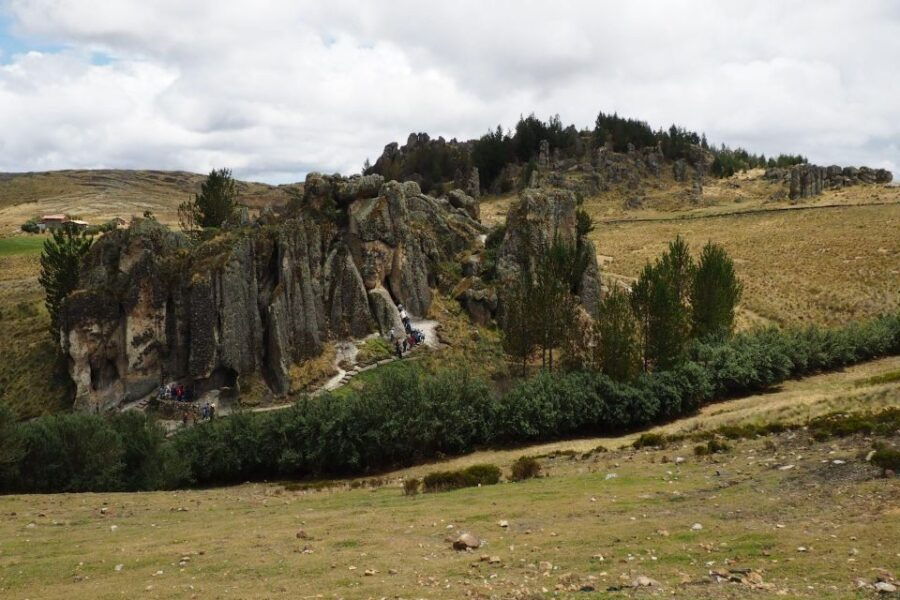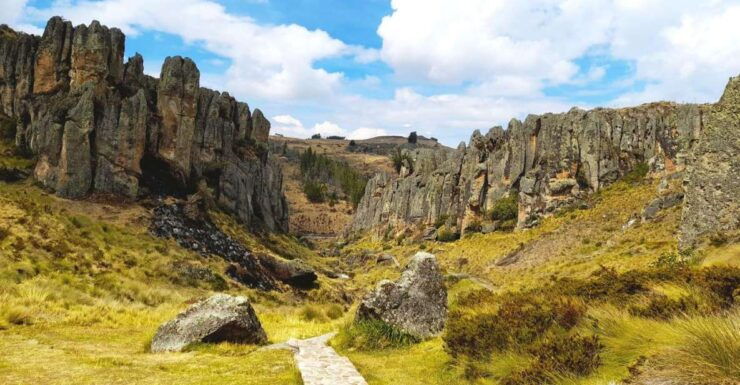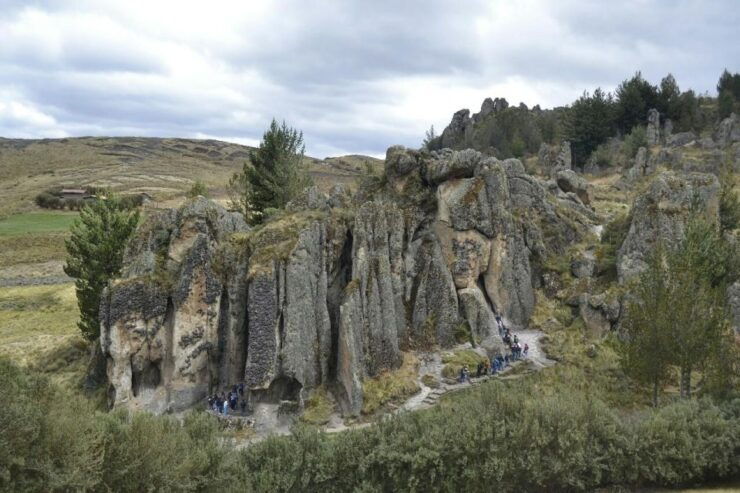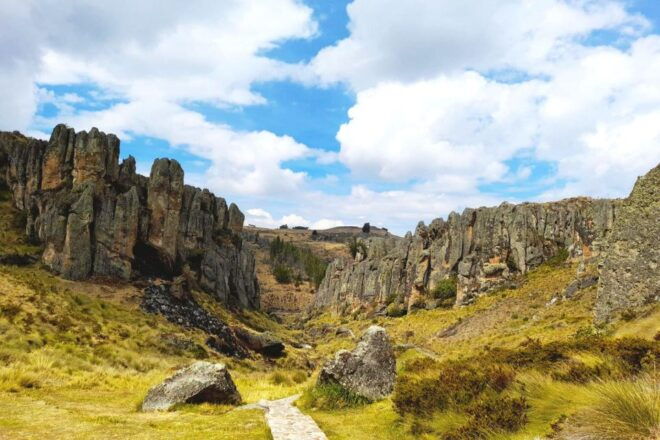In the world of archaeology, the saying ‘history is written in stone’ holds true at the Cajamarca Archaeological Complex of Cumbemayo.
As visitors navigate through this ancient site, they are met with a tapestry of mysteries waiting to be unraveled.
From the intricate water channels dating back centuries to the enigmatic purpose of the aqueduct, Cumbemayo offers a journey into the depths of Peruvian history.
But what truly lies behind the veil of these ancient marvels? Let’s explore the hidden stories that await discovery within this fascinating complex.
Good To Know

- Cumbemayo aqueduct’s construction dates back to 1000 B.C.
- The aqueduct’s purpose remains a mystery.
- Surrounding stone forest features large monoliths called frailones.
- Engravings in rock caves near the aqueduct add to the site’s enigmatic nature.
Historical Significance of Cumbemayo

Nestled in the captivating landscape of Cajamarca, the Archaeological Complex of Cumbemayo holds immense historical significance dating back to around 1000 B.C.
The site’s cultural significance is profound, as it provides a glimpse into the ancient mysteries of the Cajamarca culture. The enigmatic nature of Cumbemayo adds to its allure, with the purpose of the elaborate water channels and the stunning stone monoliths remaining a puzzle.
The region’s ability to supply water through the 9-kilometer viaduct showcases the advanced knowledge of the ancient inhabitants. Cumbemayo’s historical importance isn’t just in its age but in the unanswered questions it poses, making it a site of great intrigue and cultural value.
Find more activities and experiences we've covered in Cajamarca.
Unique Water Engineering Feat

The enigmatic water engineering feat at the Archaeological Complex of Cumbemayo showcases the advanced skills of the ancient Cajamarca culture, leaving visitors intrigued by its purpose and complexity.
The aqueduct’s construction around 1000 B.C. demonstrates the remarkable ancient technology utilized by the Cajamarca culture.
The intricate system of water channels reflects the cultural practices and ingenuity of the ancient inhabitants.
The aqueduct’s function, which remains a mystery, highlights the enigmatic nature of this ancient engineering marvel.
The region’s abundant water supply and the aqueduct’s design challenge visitors to ponder its purpose and significance in the context of Cajamarca’s history.
Enigmatic Rock Engravings

Engrossed in the ancient stones of Cumbemayo, intricate rock engravings unveil stories of a past shrouded in mystery and wonder. These enigmatic carvings offer a glimpse into the cultural significance of the site, sparking debates among experts on rock art interpretation. The symbols and figures etched into the rocks leave archaeologists puzzled, trying to decipher their meanings and connections to the ancient Cajamarca culture. Each stroke on the stone seems to whisper tales of rituals, beliefs, and daily life from centuries ago, inviting visitors to contemplate the mysteries hidden within the rocks of Cumbemayo.
| Rock Engravings | Interpretation |
|---|---|
| Symbols | Rituals |
| Figures | Beliefs |
| Carvings | Daily Life |
Mysterious Aqueduct Function
Amidst the enigmatic rock engravings that tell tales of ancient rituals and beliefs at Cumbemayo, the function of the mysterious aqueduct continues to intrigue researchers and visitors alike. Theories surrounding the aqueduct’s purpose include:
Aqueduct Theories: Some speculate it was used for irrigation purposes to support agriculture in the region.
Cultural Rituals: Others believe the aqueduct played a role in important cultural ceremonies or rituals.
Sacred Symbolism: There’s a hypothesis suggesting that the water flowing through the aqueduct held symbolic significance in the spiritual practices of the ancient Cajamarca culture.
Mystical Significance: It’s also proposed that the aqueduct might’ve been considered a sacred site, with water being a vital element in the spiritual beliefs of the people.
Scenic Highlights of Cumbemayo
Nestled amidst the captivating landscape of Cumbemayo are breathtaking vistas that showcase the natural beauty of the region. Visitors to Cumbemayo are greeted with an array of natural wonders perfect for landscape photography enthusiasts.
The site features a forest of large stone monoliths known as frailones, adding a mystical touch to the scenery. Water still flows along the impressive 9-kilometer viaduct, hinting at the advanced engineering skills of the ancient Cajamarca culture.
A must-see stop is the Bellavista viewpoint, offering fantastic views of the Cajamarca valley that will leave visitors in awe. These scenic highlights of Cumbemayo provide a perfect backdrop for capturing the essence and beauty of this historic site.
Tour Details and Logistics
Visitors embarking on the tour of the Cajamarca Archaeological Complex of Cumbemayo can anticipate a comprehensive experience that delves into the historical and engineering marvels of this ancient site.
Tour Details:
Transportation Options:
- Hotel pickup is included for convenience.
- Visitors should wait in the hotel lobby 10 minutes before the scheduled pickup time.
Duration and Language:
- The tour lasts approximately 4 hours.
- Live tour guides are available in Spanish and English for a richer experience.
Flexibility and Cancellation:
- Free cancellation is available up to 24 hours in advance for a full refund.
- Reserve now and pay later to keep travel plans flexible.
Common Questions
Are There Any Specific Rituals or Ceremonies Known to Have Taken Place at Cumbemayo in Ancient Times?
In ancient times at Cumbemayo, ritual practices and ceremonial events were part of the ancient beliefs and spiritual traditions. Specific rituals, possibly related to human sacrifices, may have occurred, adding to the enigmatic nature of the site.
What Materials Were Used in the Construction of the Cumbemayo Aqueduct?
Building materials for the Cumbemayo aqueduct included stones and clay. Construction techniques involved stacking stones and using clay as mortar. The aqueduct’s function remains a mystery, adding to the enigmatic nature of this ancient hydraulic engineering marvel.
Are There Any Theories or Speculations About the Purpose of the Engravings Found in the Rock Caves Near Cumbemayo?
Possible theories suggest that the engravings found in the rock caves near Cumbemayo could be linked to ancient rituals. These intricate carvings may have served as ceremonial sites or religious symbols, adding to the enigmatic nature of this archaeological complex.
How Has the Surrounding Landscape of Cumbemayo Changed Over the Centuries Since Its Construction?
Over the centuries, the landscape surrounding Cumbemayo has undergone environmental changes, impacting its cultural significance. The evolution of the terrain reflects the historical context of the area, highlighting the interplay between nature and human influence on this ancient site.
Are There Any Local Myths or Legends Associated With Cumbemayo That Are Not Commonly Known?
Local folklore surrounding Cumbemayo holds hidden stories of mystical creatures inhabiting the stone forest. Legends speak of spirits guarding the aqueduct, and tales suggest ancient rituals conducted in its shadow, adding intrigue to this enigmatic site.
The Sum Up
Discover the ancient wonders of the Archaeological Complex of Cumbemayo in Cajamarca, Peru. With its intricate water channels, enigmatic rock engravings, and stunning scenic views, this site offers a fascinating glimpse into the history and culture of the Cajamarca culture.
Join a guided tour to unravel the mysteries of this pre-Columbian hydraulic marvel and learn about the rich heritage of Peru.
Don’t miss the opportunity to explore this unique archaeological gem!
You can check if your dates are available here: